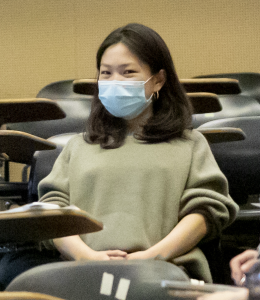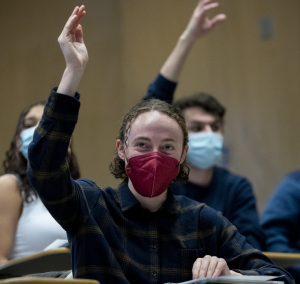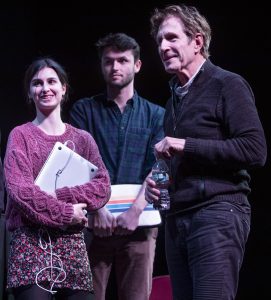By Matt Chlastawa (BFF 2019; Bates Class of 2020)
The goal of a film is to tell a story. Unfortunately, there is no point in telling a story if no one is willing to listen. To peak curiosity in an audience is an art. This is the goal of any marketing campaign, to promote stories worth listening to. Marketing is a very large part of running a successful film festival, and an underrated aspect of the programming process. Although marketing can be a fun and fulfilling craft to practice, like any craft, there are bound to be unexpected challenges. I would love to show you a little behind the scenes look into the Bates Film Festival 2019 Marketing Campaign. The ups, downs, should haves, and could haves. Like any art, marketing has many different forms of expression. We tried to utilize the power of social media, while still putting the pieces together. Our marketing team learned to communicate while navigating ambiguity. Before noting the overarching takeaways from the 2019 Marketing campaign, I would like to first introduce some background on my perspective.

I love marketing because I love the storytelling process. I have spent two summers interning within the marketing department of a small community bank in my town, where I was given many opportunities to write promotional copy. I have made collaborative surveys, and have had experience utilizing social media for brand purposes. I have taken two practitioner-led courses on marketing, one taught by Simone Anselmi while studying abroad in Florence, Italy, and the other taught by Bates grad Eugene Kim ’08. Both practitioners have emphasized the significance of communicating a brand’s “why.” Why does the Bates Film Festival exist? Why do we program the types of movies that we do? These types of questions are vital in laying the foundation of good marketing. In order to figure out “how” and “what” to communicate to an audience, as a marketer, we must first establish a meaningful purpose that calls for communication. During our marketing process, I often found myself thinking about Simon Sinek’s Golden Circle. If you have the time, I would recommend his famous Ted Talk that outlines the importance of starting with “why.”

I stress the influence of marketing because it cannot be separated from the overall programing and organization of the festival itself. Even within the complicated process of selecting films to showcase, each individual work holds a certain level of marketability. This complexity can best be seen behind closed doors in the discussions and arguments had over what films should be shown. Factors such as influence, identifiability, and marketability become tokens of argumentation, as board members naturally stray away from the overarching “why” in an attempt to have a certain film shown. Bill Nichols talks about this interesting complexity in “Global Image Consumption in the Age of Late Capitalism.” In the decision-making process he notes that, “Questions of originality, authenticity, and influence diminish as issues of marketability and desirability arise” (34). In this he highlights the complexity of marketing a film festival. Unlike other products and brands that I have worked with, the Bates Film Festival intended to showcase a set of products that, “advance the College’s mission” (BFF Mission Statement). This involved debates of marketability and popularity with, “work that cultivates productive discussions of topical social and political issues” (Mission Statement). Marketability and the Bates College mission statement are not necessarily mutually exclusive. However, they have influenced the way in which we looked to promote the Bates Film Festival. In retrospect, it is easy to see how the relationship between questions of originality and marketability manifested themselves in conversations about programing and promotion. The complexity of programing and dealing with these issues resulted in necessary adaptation to our marketing strategy. We were able to align the Bates College mission statement with the festival’s and in doing so, solidify our purpose. I would continue to suggest that having this as our guiding moral compass helped all of our marketing decisions. Fortunate for us, we were not heavily restricted by corporate sponsorship. This point is made by the University of Chicago Student Nora Gonzalez in “Doc Films is Movie History.” “We don’t have to worry about making a profit like other theaters in Chicago do,” Gonzalez says, “So I think it gives us a little more flexibility” (Myers, 2). Similarly, the financial structure of the Bates Film Festival allowed us to navigate ambiguity with minimal restriction.
The unexpected challenges I wanted to highlight within the Bates Film Festival included promotion without solidified information, maintaining social media accounts, and the consequences from lack of prioritization. It takes time to program all the films in a festival. One must decide and acquire films, solidify guests, and themes. As a result, we were tasked to promote the festival that was not completely put together. The logo took some time, and we could not do merchandising material before we agreed on a logo. The promotion of ambiguous details made marketing relatively difficult to navigate. It was only when we had our solidified schedule of events, logo, and guests that we were able to actively utilize social media outlets.
“It takes time to program all the films in a festival. One must decide and acquire films, solidify guests, and themes. As a result, we were tasked to promote the festival that was not completely put together.“
On the outside everything seemed to be coming together, however our focus on the overarching success of screenings hid the valuable strategy of prioritization. We looked to promote every film equally. In reflection, I guess that it seemed unfair to rank the art. One perspective can be that to compare two films is to compare an apple to an orange. To some extent this is true. Yet, this belief hardly aligns with the programming and marketing benefits of prioritizing events within the schedule. Prioritization sticks out to me as significant because it helps avoid unexpected misfortune as priority events receive the most attention. For instance, events that have visiting guests should be heavily promoted. Q&A’s and panels work best with an interactive audience, and those participating within the event hold a special grassroots marketing opportunity as a prosumer. In retrospect, I wish that we prioritized certain events in order of desired attendance in order to get a clear picture as to what events should be heavily promoted. If the future of the Bates Film Festival decides to keep everything in house, I think prioritizing events can help us adequately promote the most influential events in our program.
One focus that I really wish we utilized more was our academic network. With the type of films that we program, on paper it seemed relatively easy to get interested students out to watch a show. It would have been better to get more class involvement with the festival, while establishing festival credibility among faculty. It doesn’t take much for a professor to offer some sort of incentive for students to attend a class-related film. I believe that a stronger line of communication with a select few professors can help us cater toward their academic desires, while aligning with our mission statement as a festival. Whether it be food, specific panel guests, or films, I believe that input from our academic network at Bates can help provide more incentives for students to attend.
“One focus that I really wish we utilized more was our academic network. With the type of films that we program, on paper it seemed relatively easy to get interested students out to watch a show. It would have been better to get more class involvement with the festival, while establishing festival credibility among faculty.“
Overall, we did the best that we could. We learned some tricks, including the role food can play in peaking curiosity. We learned how to best market through uncertainty, noticing how nice it would be to have all the pieces of the festival in place before we start marketing for it. We learned the consequences of not prioritizing events as a programming board, resulting in unanticipated attendance numbers. We also learned the importance of our surrounding resources. We did not use all of our available resources, however the outside resources we did use proved to be invaluable. From booking food to outsourcing our logo, we found the benefits of asking for a helping hand. It then begs the question. What type of impact could a media sponsor have on the Bates Film Festival?
Works Cited
Bates Film Festival. “2019 Bates Film Festival Mission Statement.” https://course-wp.bates.edu/rhet391/mission/.
Myers, Quinn. “Doc Films Is Movie History.” Chicago Reader, 4 Dec. 2019, www.chicagoreader.com/chicago/doc-films-university-of-chicago/Content?oid=70138302.
Nichols, Bill. “Global Image Consumption in the Age of Late Capitalism.” In The Film Festival Reader. 33–35. St. Andrews: St Andrews Film Studies, 2014.






